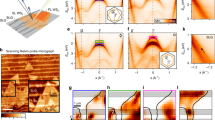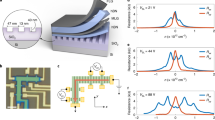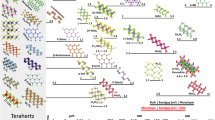Abstract
The ability to manipulate electrons in two-dimensional materials with external electric fields provides a route to synthetic band engineering. By imposing artificially designed and spatially periodic superlattice potentials, electronic properties can be further altered beyond the constraints of naturally occurring atomic crystals1,2,3,4,5. Here, we report a new approach to fabricate high-mobility superlattice devices by integrating surface dielectric patterning with atomically thin van der Waals materials. By separating the device assembly and superlattice fabrication processes, we address the intractable trade-off between device processing and mobility degradation that constrains superlattice engineering in conventional systems. The improved electrostatics of atomically thin materials allows smaller wavelength superlattice patterns relative to previous demonstrations. Moreover, we observe the formation of replica Dirac cones in ballistic graphene devices with sub-40 nm wavelength superlattices and report fractal Hofstadter spectra6,7,8 under large magnetic fields from superlattices with designed lattice symmetries that differ from that of the host crystal. Our results establish a robust and versatile technique for band structure engineering of graphene and related van der Waals materials with dynamic tunability.
This is a preview of subscription content, access via your institution
Access options
Access Nature and 54 other Nature Portfolio journals
Get Nature+, our best-value online-access subscription
$29.99 / 30 days
cancel any time
Subscribe to this journal
Receive 12 print issues and online access
$259.00 per year
only $21.58 per issue
Buy this article
- Purchase on Springer Link
- Instant access to full article PDF
Prices may be subject to local taxes which are calculated during checkout




Similar content being viewed by others
References
Esaki, L. & Tsu, R. Superlattice and negative differential conductivity in semiconductors. IBM J. Res. Dev. 14, 61–65 (1970).
Ismail, K., Chu, W., Yen, A., Antoniadis, D. A. & Smith, H. I. Negative transconductance and negative differential resistance in a grid-gate modulation-doped field-effect transistor. Appl. Phys. Lett. 54, 460–462 (1989).
Weiss, D., Klitzing, K. V., Ploog, K. & Weimann, G. Magnetoresistance oscillations in a two-dimensional electron gas induced by a submicrometer periodic potential. Europhys. Lett. 8, 179–184 (1989).
Schlösser, T., Ensslin, K., Kotthaus, J. P. & Holland, M. Landau subbands generated by a lateral electrostatic superlattice—chasing the Hofstadter butterfly. Semicond. Sci. Technol. 11, 1582–1585 (1996).
Albrecht, C. et al. Evidence of Hofstadter’s fractal energy spectrum in the quantized Hall conductance. Phys. Rev. Lett. 86, 147–150 (2001).
Dean, C. R. et al. Hofstadter’s butterfly and the fractal quantum Hall effect in moiré superlattices. Nature 497, 598–602 (2013).
Ponomarenko, L. A. et al. Cloning of Dirac fermions in graphene superlattices. Nature 497, 594–597 (2013).
Hunt, B. et al. Massive Dirac fermions and Hofstadter butterfly in a van der Waals heterostructure. Science 340, 1427–1430 (2013).
Hua Wang, Q., Kalantar-Zadeh, K., Kis, A., Coleman, J. N. & Strano, M. S. Electronics and optoelectronics of two-dimensional transition metal dichalcogenides. Nat. Nanotech. 7, 699–712 (2012).
Park, C.-H., Yang, L., Son, Y.-W., Cohen, M. L. & Louie, S. G. Anisotropic behaviours of massless Dirac fermions in graphene under periodic potentials. Nat. Phys. 4, 213–217 (2008).
Park, C. H., Son, Y. W., Yang, L., Cohen, M. L. & Louie, S. G. Electron beam supercollimation in graphene superlattices. Nano Lett. 8, 2920–2924 (2008).
Barbier, M., Vasilopoulos, P. & Peeters, F. M. Extra Dirac points in the energy spectrum for superlattices on single-layer graphene. Phys. Rev. B 81, 75438 (2010).
Dubey, S. et al. Tunable superlattice in graphene to control the number of Dirac points. Nano Lett. 13, 3990–3995 (2013).
Drienovsky, M. et al. Towards superlattices: lateral bipolar multibarriers in graphene. Phys. Rev. B 89, 115421 (2014).
Drienovsky, M. et al. Few-layer graphene patterned bottom gates for van der Waals heterostructures. Preprint at https://arxiv.org/abs/1703.05631 (2017).
Sun, Z. et al. Towards hybrid superlattices in graphene. Nat. Commun. 2, 559 (2011).
Bai, J., Zhong, X., Jiang, S., Huang, Y. & Duan, X. Graphene nanomesh. Nat. Nanotech. 5, 190–194 (2010).
Sandner, A. et al. Ballistic transport in graphene antidot lattices. Nano Lett. 15, 8402–8406 (2015).
Yagi, R. et al. Ballistic transport in graphene antidot lattices. Phys. Rev. B 92, 195406 (2015).
Zhang, Y., Kim, Y., Gilbert, M. J. & Mason, N. Electronic transport in a two-dimensional superlattice engineered via self-assembled nanostructures. Preprint at https://arxiv.org/abs/1703.05689 (2017).
Yankowitz, M., Xue, J. & LeRoy, B. J. Graphene on hexagonal boron nitride. J. Phys. Condens. Matter 26, 303201 (2014).
Lee, M. et al. Ballistic miniband conduction in a graphene superlattice. Science 353, 1526–1529 (2016).
Scarabelli, D. et al. Fabrication of artificial graphene in a GaAs quantum heterostructure. J. Vac. Sci. Technol. B 33, 06FG03 (2015).
Lee, G.-H. et al. Electron tunneling through atomically flat and ultrathin hexagonal boron nitride. Appl. Phys. Lett. 99, 243114 (2011).
Britnell, L. et al. Electron tunneling through ultrathin boron nitride crystalline barriers. Nano Lett. 12, 1707–1710 (2012).
Wang, L. et al. One-dimensional electrical contact to a two-dimensional material. Science 342, 614–617 (2013).
Park, C. H., Yang, L., Son, Y. W., Cohen, M. L. & Louie, S. G. New generation of massless Dirac fermions in graphene under external periodic potentials. Phys. Rev. Lett. 101, 126804 (2008).
Hofstadter, D. R. Energy levels and wave functions of Bloch electrons in rational and irrational magnetic fields. Phys. Rev. B 14, 2239–2249 (1976).
Langbein, D. The tight-binding and the nearly-free-electron approach to lattice electrons in external magnetic fields. Phys. Rev. 180, 633–648 (1969).
Wannier, G. H. A result not dependent on rationality for Bloch electrons in a magnetic field. Phys. Status Solidi B Basic Solid State Phys. 88, 757–765 (1978).
Claro, F. H. & Wannier, G. H. Magnetic subband structure of electrons in hexagonal lattices. Phys. Rev. B 19, 6068–6074 (1979).
MacDonald, A. H. Landau-level subband structure of electrons on a square lattice. Phys. Rev. B 28, 6713–6717 (1983).
Geim, A. K. & Grigorieva, I. V. Van der Waals heterostructures. Nature 499, 419–425 (2014).
Acknowledgements
Development of the device concept and fabrication process was supported by the Office of Naval Research (ONR) Young Investors Program (no. N00014-17-1-2832). Investigation of the fractal band structure under applied magnetic fields was supported by the National Science Foundation (DMR-1462383). C.F. was supported by National Science Foundation (NSF) Graduate Research Fellowship Program (DGE-14-44869) and the NSF Integrative Graduate Education and Research Training fellowship program (DGE-1069240). A portion of this work was performed at the National High Magnetic Field Laboratory, which is supported by National Science Foundation Cooperative Agreement no. DMR-0654118, the State of Florida and the US Department of Energy. STM work is supported by the ONR (no. N00014-14-1-0501). P.M. acknowledges the support of New York University (NYU) Shanghai (Start-up Funds), NYU-ECNU (East China Normal University) Institute of Physics, and the NSF of China Research Fund for International Young Scientists (grant no. 11550110177). This research was carried out on the High Performance Computing resources at NYU Shanghai. M.K. was supported by JSPS (Japan Society for the Promotion of Science) KAKENHI (grant no. JP25107005, JP25107001 and JP15K21722). P.K. acknowledges support from ONR Multidisciplinary University Research Initiatives program on Quantum Optomechanics (grant no. N00014-15-1-2761).
Author information
Authors and Affiliations
Contributions
C.F., P.K. and C.R.D. conceived of the experiment. C.F. fabricated the samples, performed transport measurements and analysed transport data. P.M. and M.K. provided theoretical modelling of the system. X.Z. and A.P. performed STM measurements and analysed STM data. C.F., P.M., M.K., A.P., P.K. and C.R.D. co-wrote the paper. K.W. and T.T. provided hBN material for device fabrication.
Corresponding author
Ethics declarations
Competing interests
The authors declare no competing interests.
Additional information
Publisher’s note: Springer Nature remains neutral with regard to jurisdictional claims in published maps and institutional affiliations.
Supplementary information
Supplementary Information
Supplementary Figures 1–14, Supplementary References
Rights and permissions
About this article
Cite this article
Forsythe, C., Zhou, X., Watanabe, K. et al. Band structure engineering of 2D materials using patterned dielectric superlattices. Nature Nanotech 13, 566–571 (2018). https://doi.org/10.1038/s41565-018-0138-7
Received:
Accepted:
Published:
Issue Date:
DOI: https://doi.org/10.1038/s41565-018-0138-7
This article is cited by
-
A moiré proximity effect
Nature Materials (2024)
-
Engineering correlated insulators in bilayer graphene with a remote Coulomb superlattice
Nature Materials (2024)
-
Topological minibands and interaction driven quantum anomalous Hall state in topological insulator based moiré heterostructures
Nature Communications (2024)
-
Flat bands, strange metals and the Kondo effect
Nature Reviews Materials (2024)
-
Synergistic correlated states and nontrivial topology in coupled graphene-insulator heterostructures
Nature Communications (2023)



